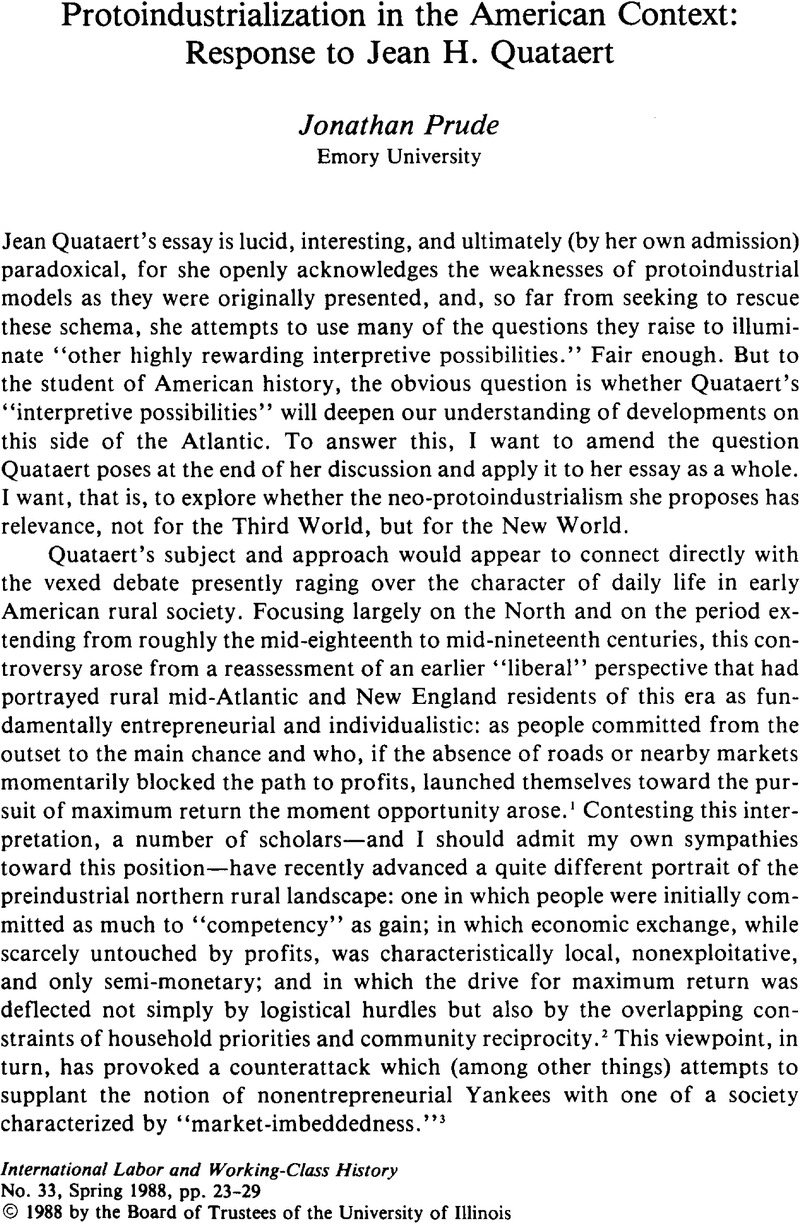No CrossRef data available.
Published online by Cambridge University Press: 16 December 2008

1. See, Lemon, James T., The Best Poor Man's Country: A Geographical Study of Early Southeastern Pennsylvania (Baltimore, 1972)Google Scholar; Grant, Charles S., Democracy in the Connecticut Frontier Town of Kent: Character and the Social Order in Connecticut, 1690–1765 (Cambridge, Mass., 1967).Google Scholar A more nuanced treatment that finds acquisitiveness both present and problematic among colonial yeomen is found in Bushman, Richard, From Puritan to Yankee: Character and the Social Order in Connecticut, 1690–1760 (Cambridge, Mass., 1967).Google Scholar
2. The texts usually cited for this stance include: Merrill, Michael, “Cash Is Good to Eat: Self-Sufficiency and Exchange in the Rural Economy of the United States,” Radical History Review 3 (Winter 1977): 42–71Google Scholar; Henretta, James, “Families and Farms: Mentalité in Pre-Industrial America,” William and Mary Quarterly 3rd ser., 35 (01 1978): 3–32CrossRefGoogle Scholar; Clark, Christopher, “Household Economy, Market Exchange, and the Rise of Capitalism in the Connecticut Valley, 1800–1860,” Journal of Social History 3 (Winter 1979): 169–85.CrossRefGoogle Scholar See also, Wilentz, Sean, “Against Exceptionalism: Class-Consciousness and the American Labor Movement,” International Labor and Working-Class History 26 (Fall 1984): 1–24, but esp. p. 7.CrossRefGoogle Scholar
3. See, for example, Rothenberg, Winifred B., “The Market and Massachusetts Farmers, 1750–1855,” Journal of Economic History 41 (06 1981): 283–314.CrossRefGoogle Scholar See also, Cronon, William, Changes in the Land: Indians, Colonists, and the Ecology of New England (New York, 1983), esp. ch. 8Google Scholar; Weiss, Rona S., “The Market and Massachusetts Farmers, 1750–1850: A Comment,”Google Scholar and Rothenberg, , “The Market and Massachusetts Farmers: Reply,” both in Journal of Economic History 43 (06 1983): 475–80.CrossRefGoogle Scholar
4. For an interesting recent effort to sort through the conceptual haze by underscoring the emergence of “capitalist labor relations,” see Bernstein, Michael A. and Wilentz, Sean, “Market, Commerce, and Capitalism in Rural Massachusetts,” Journal of Economic History 44 (03 1984): 171–73.CrossRefGoogle Scholar
5. Prude, Jonathan, The Coming of Industrial Order: Town and Factory Life in Rural Massachusetts, 1800–1860 (New York, 1983), ch. 1Google Scholar; Clark, Christopher, “Work, Economy, and Culture in Rural Massachusetts: The Connecticut Valley, 1750–1830,” paper presented to the Third International Conference of the Centre de recherches sur l'histoire des Etats-Unis (1987)Google Scholar; see, also, Tryon, Rolla M., Household Manufactures in the; United States, 1640–1860: A Study in Industrial History (Chicago, 1917)Google Scholar; Hahn, Steven, The Roots of Southern Populism: Yeoman Farmers and the Transformation of the Georgia Upcountry, 1850–1890 (New York, 1983), chs. 1–3.Google Scholar
6. Dublin, Thomas, “Women and Outwork in a Nineteenth-Century New England Town: Fitzwilliam, New Hampshire, 1830–1850” in The Countryside in the Age of Capitalist Transformation: Essays in the Social History of Rural America, ed. Hahn, Steven and Prude, Jonathan (Chapel Hill, 1985), 51–69Google Scholar; Nobles, Greg, “An Overview of the Rural Network in Nineteenth Century New England,” paper presented to the Third International Conference of the Centre de recherches sur l'histoire des Etats-Unis (1987).Google Scholar
7. See Nobles, , “Overview,”Google Scholar and Clark, , “Household Economy, Market Exchange, and the Rise of Capitalism.”Google Scholar
8. Prude, , Coming of Industrial Order, chs. 3–6Google Scholar; Kulik, Gary, “Pawtucket Village and the Strike of 1824: The Origins of Class Conflict in Rhode Island,” Radical History Review 17 (Spring 1978): 5–37CrossRefGoogle Scholar; and “Dams, Fish, and Farmers: Defense of Public Rights in Eighteenth-Century Rhode Island,” in Countryside, ed. Hahn, and Prude, , 25–50.Google Scholar
9. On the problems and possibilities of comparative analysis of households, as well as on the dynamics of antebellum southern household production, I have benefitted from Fox-Genovese, Elizabeth, Within the Plantation Household: Black and White Women of the Old South (Chapel Hill, forthcoming), ch. 2.Google Scholar See also, Faragher, John Mack, Sugar Creek: Life on the Illinois Prairie (New Haven, 1987).Google Scholar